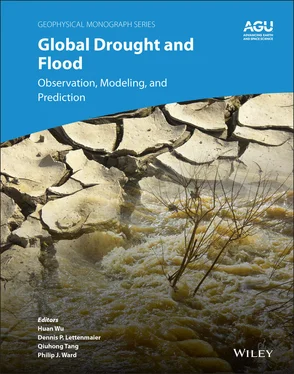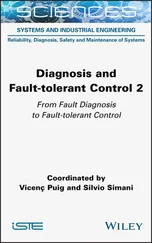1 Cover
2 Series Page
3 Title Page Geophysical Monograph 265
4 Copyright Page
5 List Of Contributors
6 Preface
7 Part I: Remote Sensing for Global Drought and Flood Observations 1 Progress, Challenges, and Opportunities in Remote Sensing of Drought 1.1. INTRODUCTION 1.2. PROGRESS IN REMOTE SENSING OF DRIVERS OF DROUGHT 1.3. MULTI‐INDICATOR DROUGHT MODELING 1.4. DROUGHT AND HEATWAVES FEEDBACKS 1.5. REMAINING CHALLENGES AND OPPORTUNITIES 1.6. CONCLUSION REFERENCES 2 Remote Sensing of Evapotranspiration for Global Drought Monitoring 2.1. INTRODUCTION 2.2. HISTORICAL SKETCH OF ET REMOTE SENSING STUDIES AND ET DATA PRODUCTS 2.3. ESTIMATING ET AND MONITORING DROUGHT WITH GEOSTATIONARY SATELLITE THERMAL OBSERVATIONS 2.4. DROUGHT MONITORING PRODUCT SYSTEM BASED ON ET REMOTE SENSING 2.5. COMBINING ET REMOTE SENSING WITH MICROWAVE SOIL MOISTURE DATA FOR DROUGHT MONITORING 2.6. DISCUSSION ACKNOWLEDGMENTS REFERENCES 3 Drought Monitoring Using Reservoir Data Collected via Satellite Remote Sensing 3.1. INTRODUCTION 3.2. DROUGHT MONITORING USING REMOTELY SENSED RESERVOIR DATA 3.3. ADOPTING REMOTELY SENSED RESERVOIR DATA TO SUPPORT DROUGHT MODELING APPLICATIONS 3.4. FUTURE DIRECTIONS 3.5. DISCUSSION AND CONCLUSIONS ACKNOWLEDGMENTS REFERENCES 4 Automatic Near‐Real‐Time Flood Mapping from Geostationary Low Earth Orbiting Satellite Observations 4.1. INTRODUCTION 4.2. DATA USED 4.3. METHODS 4.4. APPLICATIONS 4.5. VALIDATION 4.6. DISCUSSION 4.7. SUMMARY ACKNOWLEDGMENTS REFERENCES 5 Global Flood Observation with Multiple Satellites: Applications in Rio Salado (Argentina) and the Eastern Nile Basin 5.1. INTRODUCTION: THE STATE OF THE SCIENCE AND NEED FOR GLOBAL SATELLITE FLOOD MAPPING 5.2. METHODS FOR GLOBAL FLOOD OBSERVATION 5.3. WATERSHED CASE STUDIES: ARGENTINA AND THE EASTERN NILE REGION 5.4. RESULTS FROM FLOOD MAPPING IN CASE STUDIES 5.5. LIMITATIONS AND FUTURE DIRECTIONS FOR THE UTILITY OF SATELLITE FLOOD‐EVENT DATA 5.6. CONCLUSION ACKNOWLEDGMENTS REFERENCES 6 Integrating Earth Observation Data of Floods with Large‐Scale Hydrodynamic Models 6.1. INTRODUCTION 6.2. EARTH OBSERVATION FLOOD DATA 6.3. INTEGRATION OF EO DATA AND FLOOD MODELS 6.4. OUTLOOK 6.5. CONCLUSION REFERENCES
8 Part II: Modeling and Prediction of Global Drought and Flood 7 Global Integrated Drought Monitoring with a Multivariate Framework 7.1. INTRODUCTION 7.2. METHOD 7.3. DATA 7.4. RESULTS 7.5. CONCLUSION REFERENCES 8 A Probabilistic Framework for Agricultural Drought Forecasting Using the Ensemble Data Assimilation and Bayesian Multivariate Modeling 8.1. INTRODUCTION 8.2. REVIEW OF CURRENT DROUGHT FORECASTING SYSTEMS 8.3. THE PROPOSED COUPLED DYNAMICAL–STATISTICAL DROUGHT FORECASTING SYSTEM 8.4. CASE STUDIES 8.5. CONCLUSIONS AND DISCUSSION REFERENCES 9 Integrating Soil Moisture Active/Passive Observations with Rainfall Data Using an Analytic Model for Drought Monitoring at the Continental Scale 9.1. INTRODUCTION 9.2. DATA AND METHOD 9.3. RESULTS 9.4. DISCUSSION AND CONCLUSIONS ACKNOWLEDGEMENTS REFERENCES 10 Global Flood Models 10.1. INTRODUCTION 10.2. TYPES OF GFM AND SPECIFIC EXAMPLES 10.3. APPLICATIONS OF GLOBAL FLOOD MODELS 10.4. INSURANCE CATASTROPHE MODELS 10.5. GFM CREDIBILITY 10.6. THE FUTURE OF GFMS REFERENCES 11 Calibration of Global Flood Models: Progress, Challenges, and Opportunities 11.1. INTRODUCTION 11.2. GLOBAL HYDROLOGICAL MODEL CALIBRATION 11.3. MAIN CHALLENGES OF CALIBRATING GLOBAL HYDROLOGICAL MODELS 11.4. EMERGING OPPORTUNITIES 11.5. SUMMARY REFERENCES 12 Digital Elevation Model and Drainage Network Data Sets for Global Flood and Drought Modeling 12.1. INTRODUCTION 12.2. GLOBAL BASELINE DIGITAL ELEVATION DATA FOR HYDROLOGICAL MODELING 12.3. GLOBAL HYDROGRAPHY DATA SETS 12.4. CHALLENGES AND OPPORTUNITIES 12.5. SUMMARY ACKNOWLEDGMENTS REFERENCES 13 Fundamental Data Set for Global Drought and Flood Modeling 13.1. INTRODUCTION 13.2. GLOBAL LAND COVER DATA SETS 13.3. DISCUSSION REFERENCES
9 Part III: Global Drought and Flood Risk Assessment, Management, and Socioeconomic Response 14 Global River Flood Risk Under Climate Change 14.1. INTRODUCTION 14.2. MODELING GLOBAL RIVER FLOOD RISK: GENERAL CONCEPTS AND METHODS 14.3. THE GLOFRIS MODELING FRAMEWORK 14.4. CAMA‐FLOOD AND ISIMIP MODELING FRAMEWORKS 14.5. THE GAR‐2015 FLOOD RISK FRAMEWORK 14.6. THE JOINT RESEARCH CENTRE MODEL 14.7. OTHER FLOOD RISK MODELS 14.8. CONCLUSIONS REFERENCES 15 Direct Tangible Damage Classification and Exposure Analysis Using Satellite Images and Media Data 15.1. INTRODUCTION 15.2. DATA AND STUDY SITE 15.3. METHOD 15.4. RESULTS 15.5. DISCUSSION 15.6. CONCLUSIONS ACKNOWLEDGMENTS REFERENCES 16 Flood Risk and Monitoring Data for Preparedness and Response 16.1. INTRODUCTION 16.2. CHALLENGES IN UNDERSTANDING AND TRUSTING FLOOD DATA 16.3. TWO CASE STUDIES FRAMING THE DISCONNECT BETWEEN FLOOD DATA DEVELOPERS AND DECISION MAKERS 16.4. IDENTIFICATION OF COMMON THEMES FOUND IN THE QUESTIONS ASKED WITHIN THE CASE STUDIES 16.5. SUGGESTED OPPORTUNITIES TO MOVE TOWARDS NARROWING THE GAP 16.6. CONCLUSION ACKNOWLEDGMENTS REFERENCES 17 Global Flood Partnership * 17.1. INTRODUCTION 17.2. MODELS AND PRODUCTS 17.3. GFP ACTIVATIONS 17.4. DISCUSSION AND CONCLUSIONS REFERENCES 18 Drought and Flood Monitoring and Forecasting 18.1. REMOTE SENSING FOR DROUGHT AND FLOOD MODELING 18.2. DROUGHT AND FLOOD MODELING 18.3. RISK ANALYSIS AND COLLABORATION 18.4. PERSPECTIVE
10 Index
11 End User License Agreement
1 Chapter 2 Table 2.1 Major inputs data for GET‐D system Table 2.2 GET‐D system outputs
2 Chapter 4Table 4.1 Comparison Between MODIS Flood Product and VIIRS Flood Product
3 Chapter 5Table 5.1 Summary of Antecedent Remote Sensing Products for Surface Water Cha...Table 5.2 Summary of Publicly Available Satellite Imagery Used for the Observ...Table 5.3 Summarized Accuracy Statistics for 13 Flood Events Comparing High‐R...
4 Chapter 9Table 9.1 Root Mean Square Error (RMSE) and Correlation Coefficient (R) of Mo...
5 Chapter 10Table 10.1 Characteristics of Global Flood Models Relative to Traditional Loc...Table 10.2 Global Flood Model DetailsTable 10.3 Different Possible Applications of Global Flood Models with Refere...
6 Chapter 12Table 12.1 Selected DEM Data Available Globally or Near GloballyTable 12.2 Selected Available Global Hydrography Database
7 Chapter 13Table 13.1 Summary of the Land‐ Cover Data Sets.
8 Chapter 14Table 14.1 List of risk models considered and their main characteristics
9 Chapter 15Table 15.1 Specifications of the Satellite GF‐1 and Satellite GF‐2 ImagesTable 15.2 Data Acquisition and Image Quality AssessmentTable 15.3 Classification of Building DamageTable 15.4 Floor Areas of Different Damaged BuildingsTable 15.5 Classification of Road DamageTable 15.6 Classification of Farmland Damage
10 Chapter 17Table 17.1 A Nonexhaustive List of GFP Flood Products Regularly Updated on th...
1 Chapter 1 Figure 1.1 Rainfall map by NASA’s Tropical Rainfall Measuring Mission (TRMM)... Figure 1.2 Near real‐time 0.04° precipitation information provided by the Gl... Figure 1.3 Near real‐time drought monitoring and prediction system by the Gl... Figure 1.4 Soil moisture observation by NASA’s Soil Moisture Active Passive ... Figure 1.5 Standardized Relative Humidity Index (SRHI) for (a) August 2010, ... Figure 1.6 Three‐month Standardized Precipitation Evapotranspiration Index (... Figure 1.7 Evaporative Stress Index (ESI) derived from observations of land ... Figure 1.8 A below‐normal snowpack observed by the Moderate Resolution Imagi... Figure 1.9 Global map of annual water storage change for the period of 2002–... Figure 1.10 Near real‐time drought monitoring and prediction system by the G... Figure 1.11 Temperature anomalies by the Moderate Resolution Imaging Spectro...
Читать дальше












